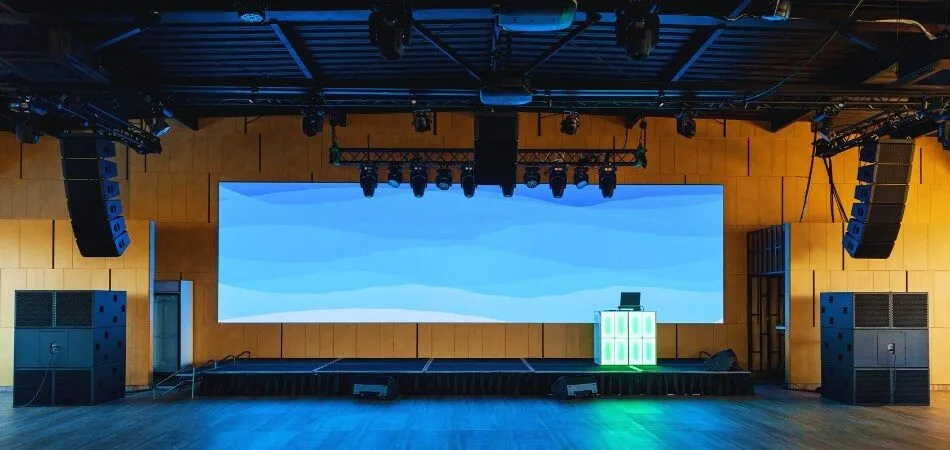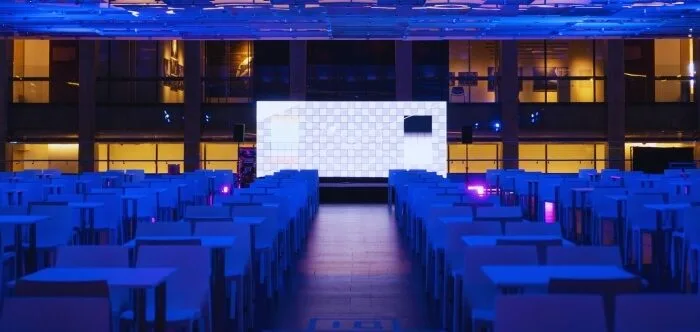The conference stage design is one of the most important factors in a successful conference. To craft an engaging and functional conference stage, we provide a step-by-step guide in our latest article, how to design a stage for a conference.
Starting with the essential task of understanding the event’s purpose, we help you select the appropriate stage size and plan a layout that works. Color schemes and lighting choices are also crucial, as they set the mood and focus for the audience.
Additionally, selecting the right audio and visual equipment is key to ensuring a smooth and impactful presentation. For a deeper dive into these elements and more expert tips, keep reading our article.
What is the Core Purpose of the Conference?
The core purpose of a conference often centers around knowledge exchange, networking, and the upbringing of professional relationships. It serves as a platform for experts to share insights, trends, and advancements in their field. Attendees benefit by gaining new information, skills, and contacts that can advance their careers.

Creating a collaborative environment is another key objective. Here, professionals from various industries can gather, discuss ideas, and brainstorm solutions to common challenges. This synergy often leads to innovative approaches and strategies, enriching the professional experience for all involved.
In essence, conferences are crucial for personal and professional growth. It can be incredibly rewarding to attend an overseas conference and get unique opportunities to step out of your everyday routine, engage with new perspectives, and be inspired by what you learn. Such experiences are invaluable for both personal development and career progression.
Significance of a Well-designed Stage for a Conference
A well-designed stage is more than just a physical space; it’s the heartbeat of a conference, setting the tone and atmosphere. It’s where ideas are shared, connections are made, and memorable experiences are born. Here are some key reasons why a well-designed stage is crucial for a conference:
- Enhances Audience Engagement: A thoughtfully designed stage captivates the audience, making presentations more impactful and engaging. It creates a focal point that draws attention and maintains interest throughout the event.
- Reflects Professionalism: A sophisticated stage design reflects the quality and professionalism of the event and its organizers. It instills confidence in attendees, assuring them of a well-planned and valuable experience.
- Facilitates Effective Communication: Good stage design includes optimal audio-visual setups, ensuring clear communication from speakers to audience. This prevents misunderstandings and ensures the message is delivered effectively.
- Supports Branding Efforts: The stage can be tailored to echo the conference’s theme or the brand’s identity, enhancing brand recall. It serves as a visual representation of the brand, leaving a lasting impression on attendees.
- Adapts to Different Formats: A versatile stage can accommodate various formats, from keynote speeches to panel discussions. This adaptability is crucial for the dynamic nature of conferences.
- Boosts Speaker Confidence: A well-equipped, well-designed stage boosts the confidence of speakers, enhancing their delivery. When speakers feel comfortable, their presentations are more dynamic and engaging.
The significance of a well-designed stage cannot be overstated. This is the foundation for a successful event such as a business conference, creating an environment where ideas can thrive and connections are formed.
Essentials You’ll Need to Design a Conference Stage
Designing a conference stage is a critical task that sets the tone for the entire event. It requires careful consideration of various elements to ensure a successful and impactful experience. From lighting to audio-visual equipment, each component plays a significant role in the overall design.
- Purposeful Layout: The stage layout must be thoughtfully planned to suit the type of presentations and audience interaction expected. It should allow easy movement for speakers and efficient use of space.
- Lighting Arrangement: Proper lighting is essential for visibility and to create the desired mood. It should be adjustable to accommodate different times of day and presentation styles.
- High-Quality Audio Equipment: Clear audio is non-negotiable for effective communication. Investing in quality microphones and speakers ensures that every word is heard.
- Visual Impact: Using screens or projectors can greatly enhance the visual experience. They should be strategically placed for optimal viewing by the entire audience.
- Comfortable Seating: Comfortable seating arrangements for the audience are crucial. It encourages longer engagement and reduces restlessness during presentations.
- Branding Elements: Incorporating branding elements, like logos and thematic colors, reinforces the conference’s identity. It creates a cohesive and memorable experience for attendees.
Designing a conference stage is about blending functionality with aesthetics. It’s about creating an environment that not only looks good but also facilitates effective communication and a comfortable experience for everyone involved.
How to Design a Stage for a Conference?
Crafting a stage for a conference is not just about aesthetics; it’s about creating a functional, engaging space that enhances the overall experience of the event. It involves careful planning and attention to detail, ensuring that every aspect of the stage design contributes positively to the conference. Here’s a detailed step-by-step guide on how to design a stage for a conference:
Step 1: Know the Conference’s Objective
Begin by comprehending the primary goals and themes of the conference. This knowledge guides the design choices, ensuring the stage is not just visually appealing but also aligns with the conference’s message and objectives, enhancing the relevance and impact of the event.
Step 2: Determine the Stage Size
Carefully evaluate the event space and expected audience size to choose an appropriate stage size. A stage too small may look cramped, while a too-large stage can seem intimidating. The key is to find a balance that accommodates speakers and equipment comfortably and suits the scale of the venue.
Step 3: Plan the Layout
Design a layout that optimizes visibility and interaction. Consider the placement of the podium, seating arrangements for panel discussions, and pathways for speakers. A well-planned layout facilitates smooth transitions between different segments of the conference and enhances audience engagement.
Step 4: Choose a Color Scheme
Choose a color scheme that reflects the conference’s theme and creates the right mood. Colors can influence attendees’ perceptions and emotions, so choose a palette that complements the conference’s tone, whether it’s energetic, formal, or innovative.
Step 5: Select Appropriate Lighting
Opt for lighting that not only ensures visibility but also enhances the atmosphere. Use a mix of spotlights for speakers and softer lighting for the audience. Consider incorporating dynamic lighting for interactive segments or highlighting important moments.
Step 6: Incorporate Audio-Visual Equipment
Ensure the audio-visual equipment is top-notch, as it’s crucial for delivering clear and effective presentations. Include high-quality microphones, speakers, and displays, and ensure they are tested and configured for optimal performance to prevent technical glitches.
Step 7: Add Finishing Touches
Personalize the stage with branding elements, decorative pieces, and appropriate signage. These final touches can transform the stage from a mere platform to a branded, immersive experience that resonates with the attendees and leaves a lasting impression.
A well-designed conference stage is a blend of functionality, aesthetics, and technology. It requires thoughtful planning and attention to detail to create a space that is not just visually pleasing but also conducive to communication and engagement. By following these steps, you can design a stage that raises the conference and provides a memorable experience for all participants.
Popular Types of Stage Layout You Can Implement in a Conference
Selecting the right stage layout for a conference is crucial in determining the event’s success. It shapes the interaction between speakers and the audience and influences the overall experience. Here are some popular types of stage layouts, each offering unique benefits to suit different conference styles.
Theatre Style
This layout mimics a traditional theatre setting, with rows of chairs facing the stage. It maximizes seating, making it ideal for large conferences where the focus is on presentations or keynote speeches. The direct sightlines to the stage ensure that attendees have a clear view of the speakers.
Classroom Style
Resembling a classroom setting, this layout has tables and chairs facing the stage. It’s perfect for educational or training sessions, where attendees might need to take notes or use laptops. This setup also allows for easy distribution of materials and facilitates learning.
U-Shape Style
The U-shape layout involves tables arranged in a U, with chairs around the outside. It’s great for workshops or smaller meetings, encouraging interaction among attendees and with the speaker. This layout is conducive to discussions, presentations, and group activities.
Boardroom Style
Ideal for executive meetings or small groups, this layout has a large table with chairs around it. It promotes a sense of equality and is conducive to open discussions and decision-making sessions. The close proximity encourages participation and collaboration.
Banquet Style
Tables are arranged around a central stage, often in round or oval shapes. This layout is suited for award ceremonies or dinners, where the stage is the focal point, but interaction among attendees is also encouraged. It allows for a mix of presentations and social interaction.
Cabaret Style
Similar to the banquet style but with chairs only around half of each table, facing the stage. This layout is ideal for events where attendees need to view the stage without turning around, and it also facilitates conversation among them.
Selecting the right stage layout is essential for the success of a conference. It should align with the event’s purpose and the type of interaction desired between speakers and attendees. The right layout can enhance the effectiveness of the communication and the overall experience of the participants.
Strategies for Choosing the Right Conference Stage Layout
Picking the right stage layout for a conference is a decision that can significantly influence the event’s success. It’s about understanding the event’s objectives and the needs of the participants. Here are some strategies to help you choose the most suitable conference stage layout.
- Identify the Conference Objectives: Understand the primary goals of the conference. This insight will guide you in choosing a layout that supports these objectives and enhances attendee engagement.
- Consider the Number of Attendees: Assess the expected number of participants. A layout must accommodate everyone comfortably without feeling overcrowded or too sparse.
- Evaluate the Type of Content: Different layouts suit different types of presentations. A keynote speech, for example, may require a different setup than a workshop or panel discussion.
- Facilitate Interaction: If interaction among attendees is key, choose layouts that encourage dialogue and participation. Round table or U-shaped layouts are often conducive to discussions.
- Prioritize Visibility and Acoustics: Ensure every attendee has a clear view of the stage and can hear clearly. Avoid layouts that may create ‘blind spots’ or poor sound distribution.
- Adaptability to Technology: The chosen layout should accommodate the necessary technical equipment, like projectors and microphones. It should also allow for easy technical troubleshooting and adjustments.
- Reflect the Event’s Theme and Branding: The layout should complement the conference’s theme and branding. It should create a cohesive and immersive experience for attendees.
Choosing the right stage layout for a conference is a crucial decision that requires careful consideration of various factors. It’s about balancing practicality with the desired atmosphere, ensuring a successful and memorable event for all participants.
Bottom Line
Designing a stage for a conference involves a blend of art and practicality, as we’ve seen in our discussion. It’s a critical task that sets the tone for the event, requiring thoughtful planning and a keen understanding of the conference’s goals.
In exploring how to design a stage for a conference, we’ve highlighted the importance of selecting the right layout, color scheme, and audio-visual elements. These choices are pivotal in enhancing audience engagement, reflecting professionalism, and ensuring effective communication.
Our journey through various stage layouts and strategies for choosing the perfect one underlines the significance of aligning every decision with the conference’s core purpose. This approach ensures a stage design that not only looks good but also resonates with the audience and speakers alike.







